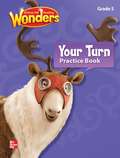- Table View
- List View
McGraw-Hill Reading Wonders [Grade K], Unit 2
by Dr Donald Bear Dr Janice Dole Dr Jana Echevarria Dr Diane AugustNIMAC-sourced textbook
McGraw-Hill Reading Wonders [Grade 6]
by Jana Echevarria Douglas Fisher Donald R. Bear Janice A. Dole Scott G. Paris Timothy Shanahan Josefina V. Tinajero Diane August Jay Mctighe David Francis Vicki Gibson Jan Hasbrouck Margaret KilgoNIMAC-sourced textbook
McGraw-Hill Reading Wonders [Grade 6]
by Jana Echevarria Douglas Fisher Donald R. Bear Janice A. Dole Scott G. Paris Timothy Shanahan Josefina V. Tinajero Diane August Jay Mctighe David Francis Vicki Gibson Jan Hasbrouck Margaret KilgoNIMAC-sourced textbook
McGraw-Hill Reading Wonders [Grade 5], Literature Anthology
by Donald R. Bear Janice A. Dole Diane AugustNIMAC-sourced textbook
McGraw-Hill Reading Wonders [Grade 5]
by Donald R. Bear Janice A. Dole Diane AugustNIMAC-sourced textbook
McGraw-Hill Reading Wonders [Grade 3]
by Jana Echevarria Douglas Fisher Donald R. Bear Janice A. Dole Scott G. Paris Timothy Shanahan Josefina V. Tinajero Diane August Jay Mctighe David Francis Vicki Gibson Jan Hasbrouck Margaret KilgoNIMAC-sourced textbook
McGraw-Hill Reading Wonders [Grade 2]
by Jana Echevarria Douglas Fisher Donald R. Bear Janice A. Dole Scott G. Paris Timothy Shanahan Josefina V. Tinajero Diane August Jay Mctighe David Francis Vicki Gibson Jan Hasbrouck Margaret KilgoNIMAC-sourced textbook
McGraw-Hill Reading Wonders [Grade 2]
by Jana Echevarria Douglas Fisher Donald R. Bear Janice A. Dole Scott G. Paris Timothy Shanahan Josefina V. Tinajero Diane August Jay Mctighe David Francis Vicki Gibson Jan Hasbrouck Margaret KilgoNIMAC-sourced textbook
McGraw-Hill Reading Wonders [Grade 1, Volume 4], Reading/Writing Workshop
by Mcgraw-Hill EducationNIMAC-sourced textbook
McGraw-Hill Reading Wonders [Grade 1, Volume 3], Reading/Writing Workshop
by Mcgraw-Hill EducationNIMAC-sourced textbook
McGraw-Hill Reading Wonders [Grade 1, Volume 3]
by Donald R. Bear Janice A. Dole Diane AugustNIMAC-sourced textbook
McGraw-Hill Reading Wonders [Grade 1, Volume 2], Reading/Writing Workshop
by Mcgraw-Hill EducationNIMAC-sourced textbook
McGraw-Hill Reading Wonders [Grade 1, Volume 2]
by Donald R. Bear Janice A. Dole Diane AugustNIMAC-sourced textbook
McGraw-Hill Reading Wonders [Grade 1, Volume 1], Reading/Writing Workshop
by Mcgraw-Hill EducationNIMAC-sourced textbook
McGraw-Hill Reading Wonders [Grade 1, Volume 1]
by Donald R. Bear Janice A. Dole Diane AugustNIMAC-sourced textbook
McGraw-Hill Reading Wonders Your Turn Practice Book
by The Editors at the McGrawHill EducationThe book intends to enhance one's reading skills by applying main focus on practice.
McGraw-Hill Reading Wonders Reading/Writing Workshop, Grade 2
by The Editors at McGraw Hill EducationMcgraw-hill Reading Wonders Reading/Writing Workshop, Grade 2.
McGraw-Hill Reading Wonders - Your Turn Practice (Tennessee Edition)
by McGraw-HillMcGraw-Hill Reading Wonders is a book full of beautifully illustrated stories and is written in a simple language. The biggest bonus in this book is cover-to-cover full-color presentation coupled with discussion questions.
McGraw-Hill Reading Wonder Works Grade 3
by Douglas Fisher Timothy Shanahan Jan HasbrouckLanguage Arts Textbook for Grade 3




















